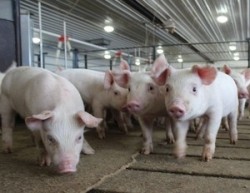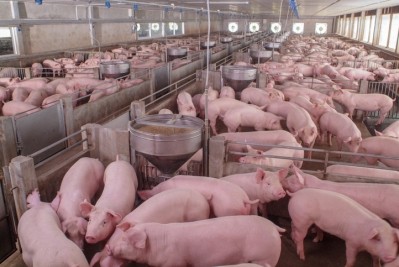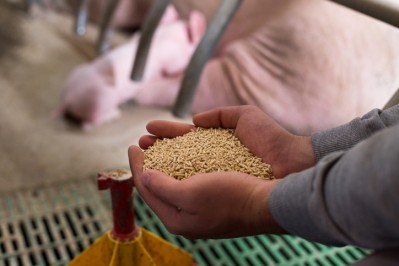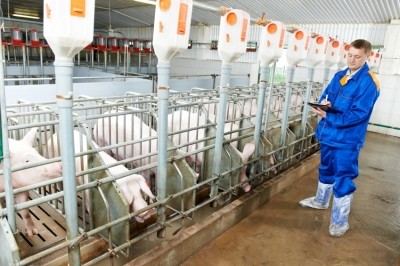Pellets, finer grinding meal may boost swine production

A group of researchers with Kansas State University examined the use of pelleted and meal diets in swine, and what happens when corn in both types of diets is finely ground.
In the experiment, they tracked average daily gain (ADG), average daily feed intake (ADFI) and the gain to feed ratio (G:F), along with carcass characteristics, they said.
The group found improvements in growth performance for pigs getting pelleted feeds, and that a finer grind improved feed efficiency for pigs on a meal diet.
“Feed costs represent about 70% of the cost of production on a swine farm, so anything we can do to make the feed better utilized really helps with profitability,” said lead researcher Bob Goodband, professor in the department of animal sciences and industry at Kansas State. “So by fine grinding feed we can increase digestibility of the diet making the pig more efficient in feed utilization, save the producer money, and help reduce nutrient excretion in the environment.”
Why feed size
Proper feed manufacturing is important, Goodband told FeedNavigator. On average, for every 100 microns a feed is decreased in particle size, there is a 1% improvement in feed efficiency. That equates to about $0.70-0.90 a pig.
“As for pelleting, it too generally saves money and improves feed efficiency,” he said. “Generally with pelleted feeds we see about a 4% improvement in average daily gain and a 4 to 6% improvement in feed efficiency.”
However, meal diets remain common because there are high costs involved with starting, operating and maintaining pelleting operations on a farm, he said.
Finely grinding feed is thought to possibly improve nutrient digestibility, said researchers, and pelleting may reduce feed waste or improve digestibility. But, there is little information available about what influence finely grinding feed ingredients before pelleting them has.
Experiment details
In the experiment, 960 pigs were allotted to one of the six experimental treatments, said researchers. The test feeds included finely (350 micron) and coarsely ground (650 micron) corn in both pellet and meal diets.
Two additional diets were made from a combination of coarsely and finely ground corn, they said. Diets were given in four phases, day 0-26, 26-46, 46-73 and 73-101.
The diets had the same primary composition of corn-soybean meal and 30% dried distillers grains with solubles for the first three phases, they said. The fourth phase only included 15% dried distillers grains.
Coarsely ground corn was done in a two-high roller mill and the finely ground corn was treated in a full circle hammer-mill, said researchers.
Pigs were weighed every two weeks and feed disappearance was noted to calculate ADG, ADFI and G:F, they said. On day 87, six of the heaviest pigs were harvested, the rest were done on day 101, and carcass yield was recorded.
Results
For the overall experimental period, a linear particle size x diet form result were noted for ADFI and G:F, said researchers.
ADFI declined and the gain to feed ratio grew as corn particle size shrank in the meal diets, they said. “We believe that this ADFI interaction is likely due to decreased palatability of the meal diets containing finer particle size corn,” they added.
“There was no particle size × diet form interaction observed for ADG; pigs fed pelleted diets had increased ADG compared with those fed meal diets,” said researchers. “However, as corn particle size decreased, so did ADG.”
Particle size did not have the same effect in the pelleted diets as ADFI remained similar for all particle sizes, they said. However, pigs getting the pelleted diets saw improved hot carcass weights.
“Pigs fed pelleted diets had improved average daily gain compared with those fed meal diets,” they said. “Feed efficiency improved as corn particle size decreased for pigs fed meal diets but not for those fed pelleted diets, suggesting that grinding corn finer than 650 μm for pelleted diets conferred no benefit.”
Finishing pigs were focused on in the feeding experiment because the majority of feed is used during the period, said Goodband. It is anticipated that results would be identical for younger pigs.
The next step of the feed-related research is set to focus on the influence that different feed milling technology has on feed processing, he said. “Our next plan is to evaluate conventional, 2-high roller mills with grain ground through a 3- or 4-high roller mill and see how the new types of roller mills affect feed processing and pig performance,” he added.
Source: Animal Feed Science and Technology
Title: Effects of diet form and corn particle size on growth performance and carcass characteristics of finishing pigs
DOI: published online before print: 10.1016/j.anifeedsci.2016.02.002
Authors: J.E. Nemechek, M.D. Tokach, S.S. Dritz, R.D. Goodband, J.M. DeRouchey, J.C. Woodworth












